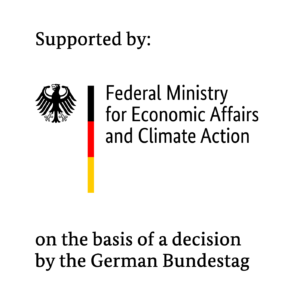Solar parks are usually checked for defects in the solar field using infrared images taken by drones. This monitoring method is particularly simple and time-efficient. Unfortunately, not all defects in the solar modules can be detected with this method and the measurement can only be carried out during the day when the solar irradiation is stable.
In the “LIEL” project, the ISFH, together with the company Aerial PV Inspection, has developed a globally unique measurement technology to inspect the condition of half-cell solar modules in large solar parks [1]. Half of the module to be inspected is excited with a short flash of light. This produces a current that flows through the second half of the module and stimulates it to electroluminesce like a light-emitting diode, cf. Fig. 1.
In the project, a lightweight inspection hood was developed that can be variably adapted to the module size. The measurement method has many special properties that no other measurement method has in this combination: The measurement can be carried out in sunlight or at night. It is not necessary to disconnect the electrical connections of the modules. The inverters also do not have to be switched off for the measurement. As shown in Fig. 2, you can simply start measuring as soon as you arrive at the solar park. There is no waiting time for suitable lighting conditions. Depending on the module, a measurement time of 50 ms to max. 200 ms is required for a measurement.
The measurement provides a high-resolution electroluminescence image of the solar module, as shown in Fig.3, for example. With the help of the electroluminescence image, an expert can assess the condition of a solar module and identify possible failure sources. With the method presented here, it can even be detected whether the modules are actively controlled by the inverter or modules are not contacted. In addition, the method is very fast. With the current prototype system, a recording of a module incl. movement to the next module and triggering of the next measurement is done in 12 s. Subsequent versions can probably reduce this test duration drastically because the actual measurement time is only max. 200 ms. The measuring device is powered by a light, carried battery that provides energy for at least 200 module measurements.
In future, the new measuring method will make it much easier to find faults in solar modules in solar parks.
The LIEL project is funded by the Central Innovation Programme for SMEs (ZIM) under funding number KK5291101BS1.
[1] M. Köntges, J. Wagner, M. Siebert, S. Bordihn, and C. Schinke, “Applicability of Light Induced Luminescence for Characterization of Internal Series-Parallel Connected Photovoltaic Modules,” IEEE J. Photovoltaics, vol. 12, no. 3, pp. 805–814, May 2022.




